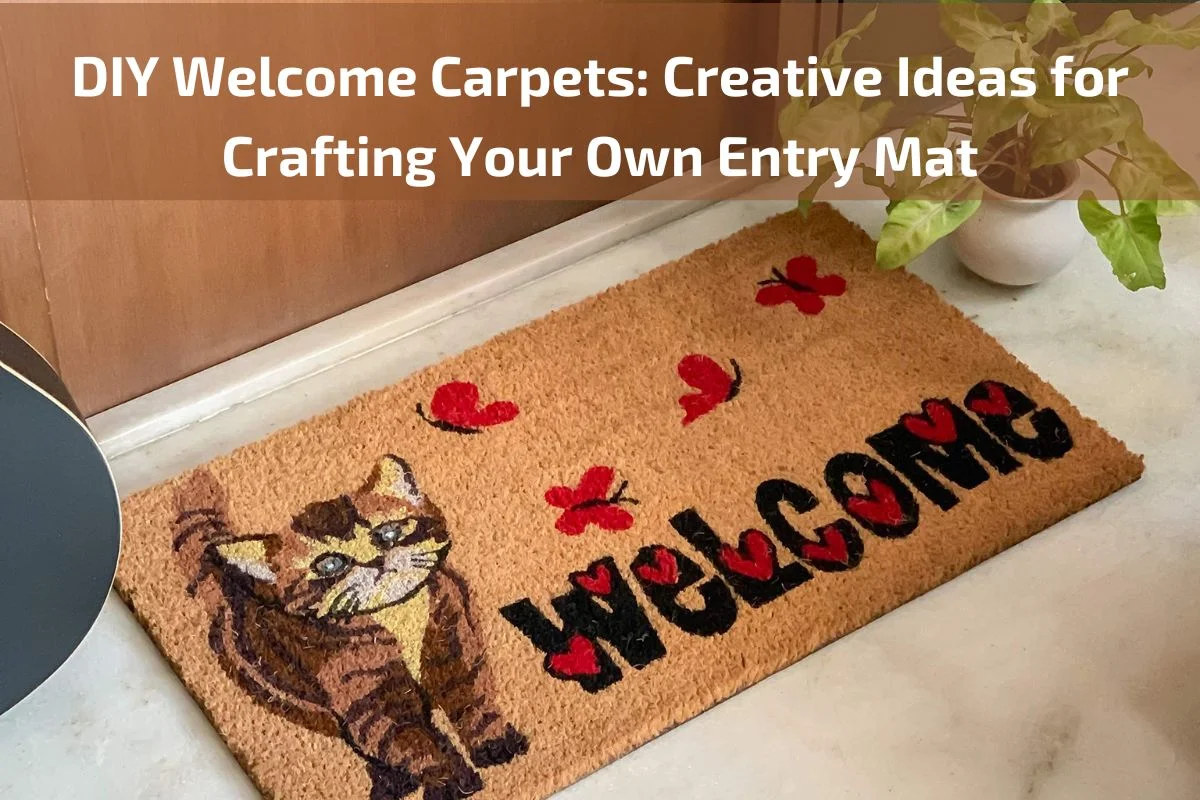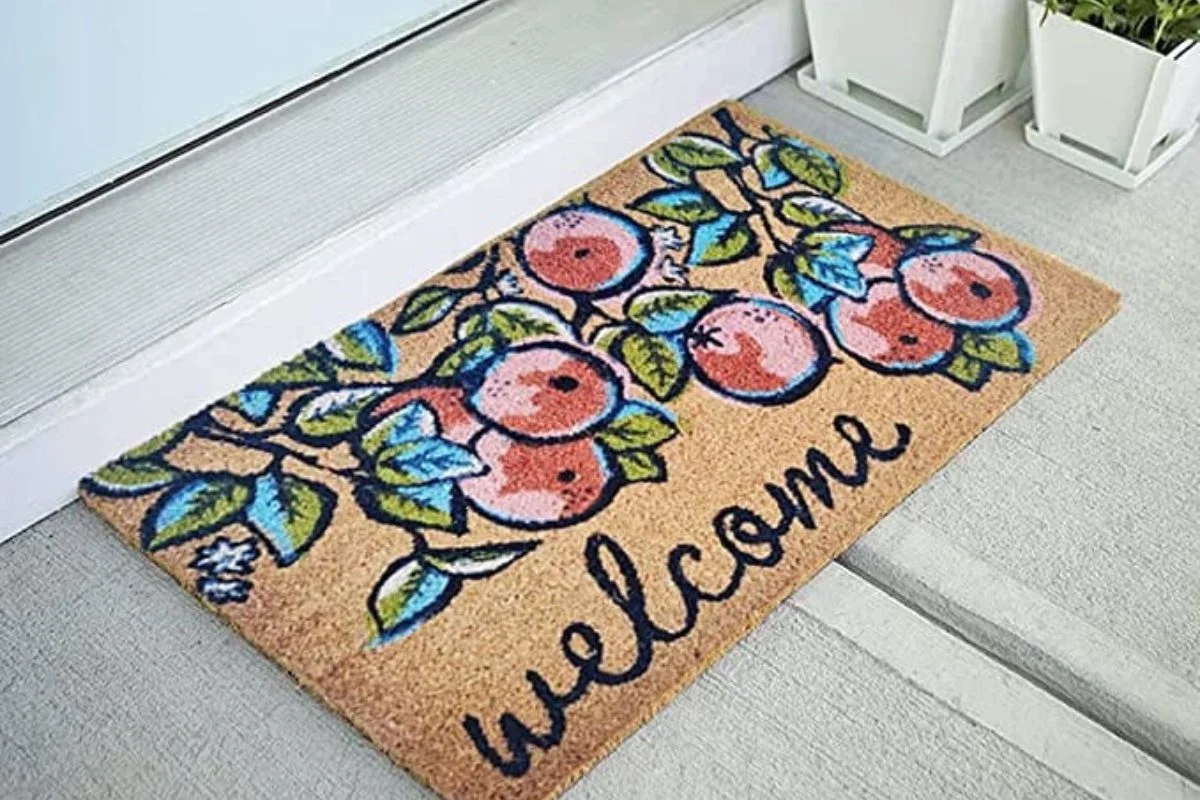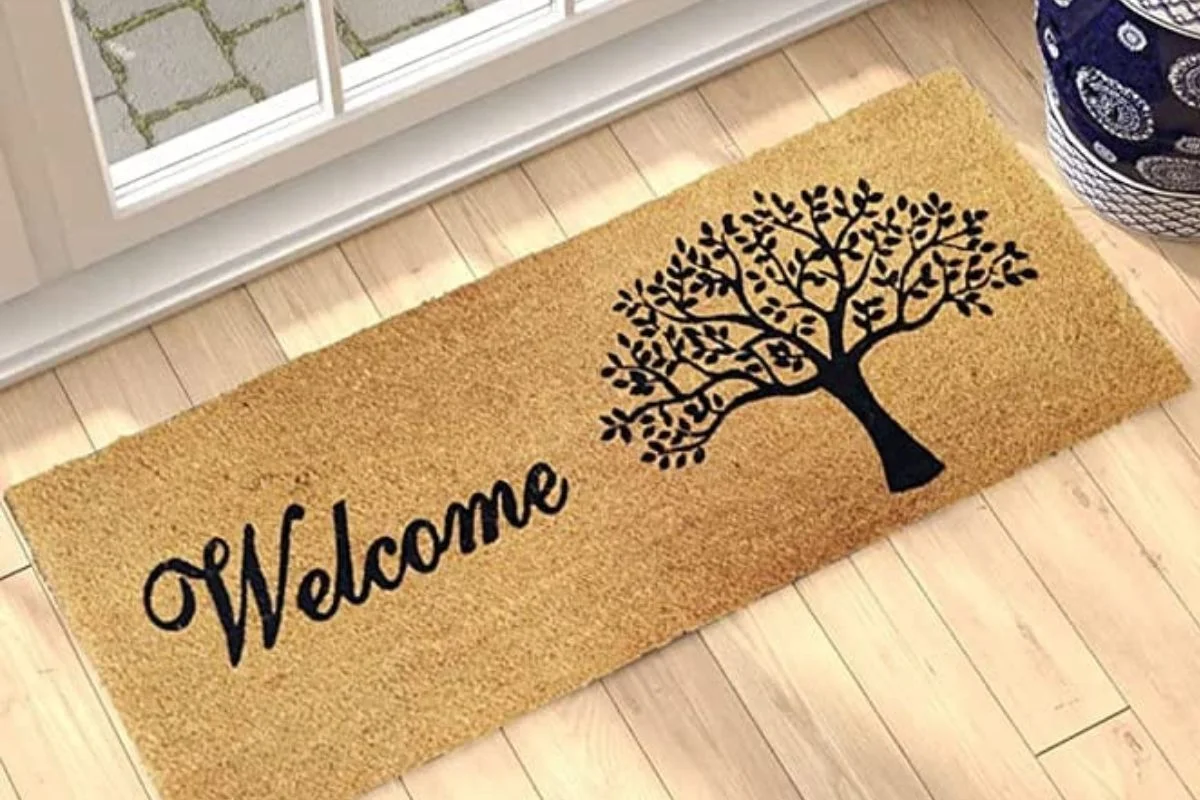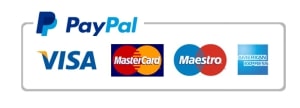
Your entryway is the first impression guests have of your home, making it the perfect place to showcase your creativity and personality. While store-bought welcome mats are convenient, crafting your own DIY welcome carpet adds a unique and personal touch to your home’s entrance. From repurposing materials to incorporating personalized designs, there are countless creative ideas for crafting a one-of-a-kind entry mat that reflects your style and welcomes visitors with warmth and charm.
In this guide, we’ll explore a variety of DIY techniques and inspirations for crafting your own welcome carpet. Whether you’re a seasoned crafter or new to the world of DIY projects, we’ll provide you with step-by-step instructions, helpful tips, and innovative ideas to spark your creativity. From hand-painted designs to upcycled materials, there’s a DIY welcome carpet idea to suit every skill level and aesthetic preference.
Join us as we embark on a journey of creativity and imagination, and discover how crafting your own welcome carpet can add a personal and inviting touch to your home’s entryway.
Importance of first impressions Welcome Carpets in home decor
First impressions matter greatly in home decor, and the welcome carpet plays a significant role in setting the tone for the entire space. Here’s why:
Warmth and Hospitality: A welcome carpet at the entrance instantly conveys a sense of warmth and hospitality to guests. It’s the first thing they encounter upon entering your home, and a well-chosen carpet can make them feel instantly welcomed.
Style and Aesthetics: The design, color, and texture of the welcome carpet contribute to the overall style and aesthetics of your home decor. Whether it’s a plush rug with intricate patterns or a simple, minimalist mat, it adds a layer of visual interest that sets the stage for the rest of the interior design.
Practicality and Functionality: Besides adding visual appeal, welcome carpets also serve a practical purpose by trapping dirt and debris from shoes, keeping the rest of your home cleaner. This functional aspect enhances the usability of your space and helps maintain cleanliness.
Personalization and Expression: Your choice of welcome carpet can reflect your personality and style preferences, allowing you to express yourself right from the entryway. Whether you opt for something classic and timeless or bold and contemporary, it’s an opportunity to make a statement about your taste.
Creating a Memorable Entry Experience: The entryway sets the stage for the rest of the home, and a well-designed welcome carpet contributes to creating a memorable entry experience for both you and your guests. It sets a positive tone and creates anticipation for what lies beyond.
Attention to Detail: Including a welcome carpet demonstrates your attention to detail in home decor. It shows that you’ve thoughtfully curated every aspect of your living space, no matter how small, to create a cohesive and inviting environment.
Types of Welcome Carpets:
There are various types of welcome carpets available, each offering unique features and characteristics to suit different preferences and needs. Here are some common types:
Coir Mats: Made from coconut husks, coir mats are durable and excellent at trapping dirt and moisture from shoes. They are often used in outdoor settings or covered entryways due to their resilience to weather conditions.
Rubber Mats: Rubber welcome mats are highly durable and weather-resistant, making them ideal for outdoor use. They are easy to clean and come in various designs and patterns to suit different decor styles.
Indoor Rugs: Indoor welcome rugs come in a wide range of materials, including wool, cotton, synthetic fibers, and blends. They offer comfort underfoot and can add a decorative touch to entryways with their diverse designs, colors, and textures.
Personalized Mats: Personalized welcome mats allow you to add a custom touch to your entryway. You can customize them with your family name, monogram, or a welcoming message, making them a unique and inviting addition to your home.
Waterhog Mats: Waterhog mats are designed to effectively trap moisture, mud, and debris from shoes, making them ideal for high-traffic areas. They feature a unique surface pattern that scrapes and absorbs dirt, keeping your floors clean and dry.
Anti-Fatigue Mats: These mats are engineered to provide cushioning and support for standing for extended periods, making them ideal for kitchen or laundry room entryways where you may spend a lot of time. They help reduce fatigue and discomfort while standing.
Seasonal Mats: Seasonal welcome mats are themed to different seasons or holidays, adding a festive touch to your entryway decor. Whether it’s a mat featuring autumn leaves for fall or a snowflake design for winter, seasonal mats can enhance the atmosphere of your home throughout the year.
Eco-Friendly Mats: For environmentally-conscious homeowners, there are welcome mats made from sustainable materials such as recycled rubber, natural fibers, or eco-friendly plastics. These mats are not only stylish but also contribute to reducing your environmental footprint.
DIY Welcome Carpet Ideas
Creating your own DIY welcome carpet is a fun and creative way to personalize your entryway while adding a unique touch to your home decor. Here are seven DIY ideas to inspire you:
Painted Coir Mat: Start with a plain coir mat and unleash your creativity by painting a custom design or pattern using outdoor acrylic paints. You can stencil on your family name, a welcoming message, or geometric patterns to add a personal touch. Seal the paint with a waterproof sealant to protect it from the elements.
Fabric Covered Mat: Transform a plain rubber or coir mat by covering it with fabric. Choose a durable outdoor fabric in a design that complements your decor. Simply cut the fabric to size, secure it to the mat using waterproof adhesive or a heavy-duty stapler, and trim any excess. This DIY project allows for endless possibilities in terms of colors and patterns.
Stenciled Mat: Use stencils to create intricate designs or motifs on a plain coir or rubber mat. You can use spray paint or acrylic paint and a stencil brush to apply the design. Choose stencils that reflect your personal style or match the theme of your home decor, such as floral patterns, geometric shapes, or seasonal motifs.
Rope Welcome Mat: Create a rustic and nautical-inspired welcome mat using thick rope and a hot glue gun. Coil the rope tightly in a spiral pattern, securing it with hot glue as you go to form the mat shape. This DIY project results in a durable and visually appealing mat that adds texture and interest to your entryway.
Plantation Shutter Mat: Repurpose old plantation shutters by cutting them into strips and weaving them together to create a unique welcome mat. Secure the strips together with screws or nails, and trim any sharp edges. This upcycled mat adds a touch of vintage charm to your entryway and is sure to impress your guests.
River Rock Mat: Collect smooth river rocks of various sizes and arrange them in a pattern on a sturdy backing material such as plywood or rubber matting. Secure the rocks in place with strong adhesive or mortar, ensuring they are evenly spaced. This DIY project creates a natural and earthy welcome mat that adds a serene touch to your entryway.
Monogrammed Pallet Wood Mat: Use reclaimed pallet wood to create a rustic welcome mat with a personalized touch. Cut the pallet wood into slats and arrange them in a rectangular shape. Paint or stencil your family monogram or initial onto the wood slats, then seal the surface with outdoor varnish for durability. This DIY mat adds a charming farmhouse vibe to your entryway.
Factors to Consider When Choosing Welcome Carpets
When selecting a welcome carpet for your home, several factors should be taken into consideration to ensure that it meets your needs and enhances your space effectively. Here are some key factors to consider:
Durability: Choose a welcome carpet that is durable and able to withstand high foot traffic, especially if it will be placed at the entrance of your home. Look for materials such as coir, rubber, or outdoor-rated fabrics that are resistant to wear and tear.
Size and Shape: Consider the size and shape of the welcome carpet in relation to the dimensions of your entryway. Make sure it fits comfortably within the space without overcrowding or appearing too small. Rectangular or oval-shaped mats are common choices, but you can also opt for custom shapes to suit your preferences.
Cleaning and Maintenance: Evaluate the ease of cleaning and maintenance required for the welcome carpet. Choose materials that are easy to clean, such as machine-washable fabrics or mats that can be easily vacuumed or hosed down. Avoid materials that trap dirt and debris, as they may require more frequent cleaning.
Weather Resistance: If the welcome carpet will be placed outdoors or in a covered area exposed to the elements, ensure that it is weather-resistant. Look for mats that are designed to withstand rain, sun exposure, and temperature fluctuations without fading or deteriorating.
Style and Design: Consider the overall style and design aesthetic of your home when choosing a welcome carpet. Select a carpet that complements your existing decor and reflects your personal taste. Whether you prefer classic, contemporary, or eclectic styles, there are welcome carpets available in a wide range of designs, colors, and patterns to suit your preferences.
Functionality: Think about the primary function of the welcome carpet, whether it’s to trap dirt and moisture from shoes, provide comfort underfoot, or simply add a decorative touch to your entryway. Choose a carpet that fulfills your specific needs while also enhancing the functionality of your space.
Budget: Set a budget for your welcome carpet purchase and consider the cost relative to the quality and features offered. While there are welcome carpets available at various price points, investing in a higher-quality carpet may offer better durability and longevity in the long run.
Safety: Ensure that the welcome carpet is safe to use and does not pose a tripping hazard, especially in high-traffic areas. Look for mats with non-slip backing or add a rug pad underneath to prevent slipping and sliding.
Tips for Maintaining Welcome Carpets
Maintaining your welcome carpet is essential to ensure it remains clean, attractive, and functional over time. Here are some tips for effectively maintaining your welcome carpets:
Regular Vacuuming: Vacuum your welcome carpet regularly to remove dirt, dust, and debris that accumulate from foot traffic. Use a vacuum cleaner with a brush attachment to loosen and lift dirt from the fibers effectively.
Shake or Beat Out: If your welcome carpet is removable, take it outside and shake it vigorously or beat it with a broom handle to dislodge embedded dirt and debris. This helps to refresh the carpet and remove excess buildup.
Spot Cleaning: Promptly attend to spills and stains on your welcome carpet to prevent them from setting and becoming more difficult to remove. Blot liquid spills with a clean cloth or paper towel, then spot clean with a mild detergent solution and water. Avoid using harsh chemicals or abrasive cleaners, as they may damage the carpet fibers.
Steam Cleaning: Periodically steam clean your welcome carpet to deep clean and sanitize the fibers. Use a steam cleaner specifically designed for carpets and follow the manufacturer’s instructions carefully. Steam cleaning helps to remove embedded dirt, odors, and bacteria, leaving your carpet fresh and revitalized.
Rotate and Flip: Rotate your welcome carpet periodically to distribute wear and tear evenly across the surface. If your carpet has a reversible design or pattern, consider flipping it occasionally to extend its lifespan and maintain its appearance.
Trim Loose Fibers: Trim any loose or frayed fibers on the surface of your welcome carpet to prevent them from unraveling further and compromising the integrity of the carpet. Use sharp scissors to carefully trim away any stray fibers, taking care not to cut into the carpet backing.
Protect from Sunlight: If your welcome carpet is placed in a location exposed to direct sunlight, consider using curtains, blinds, or UV-protective window film to prevent fading and discoloration. Sunlight exposure can cause colors to fade over time, so minimizing exposure helps to preserve the vibrancy of your carpet.
Use Mats or Rugs: Place additional mats or rugs outside and inside entryways to trap dirt and moisture before it reaches your welcome carpet. These secondary mats help to reduce the amount of debris tracked indoors, extending the lifespan of your welcome carpet and minimizing the need for frequent cleaning.
Conclusion
In conclusion, welcome carpets play a crucial role in home decor by setting the tone for your entryway and creating a welcoming atmosphere for both residents and guests. Their importance lies not only in their aesthetic appeal but also in their practical functionality in trapping dirt, moisture, and debris from shoes.




